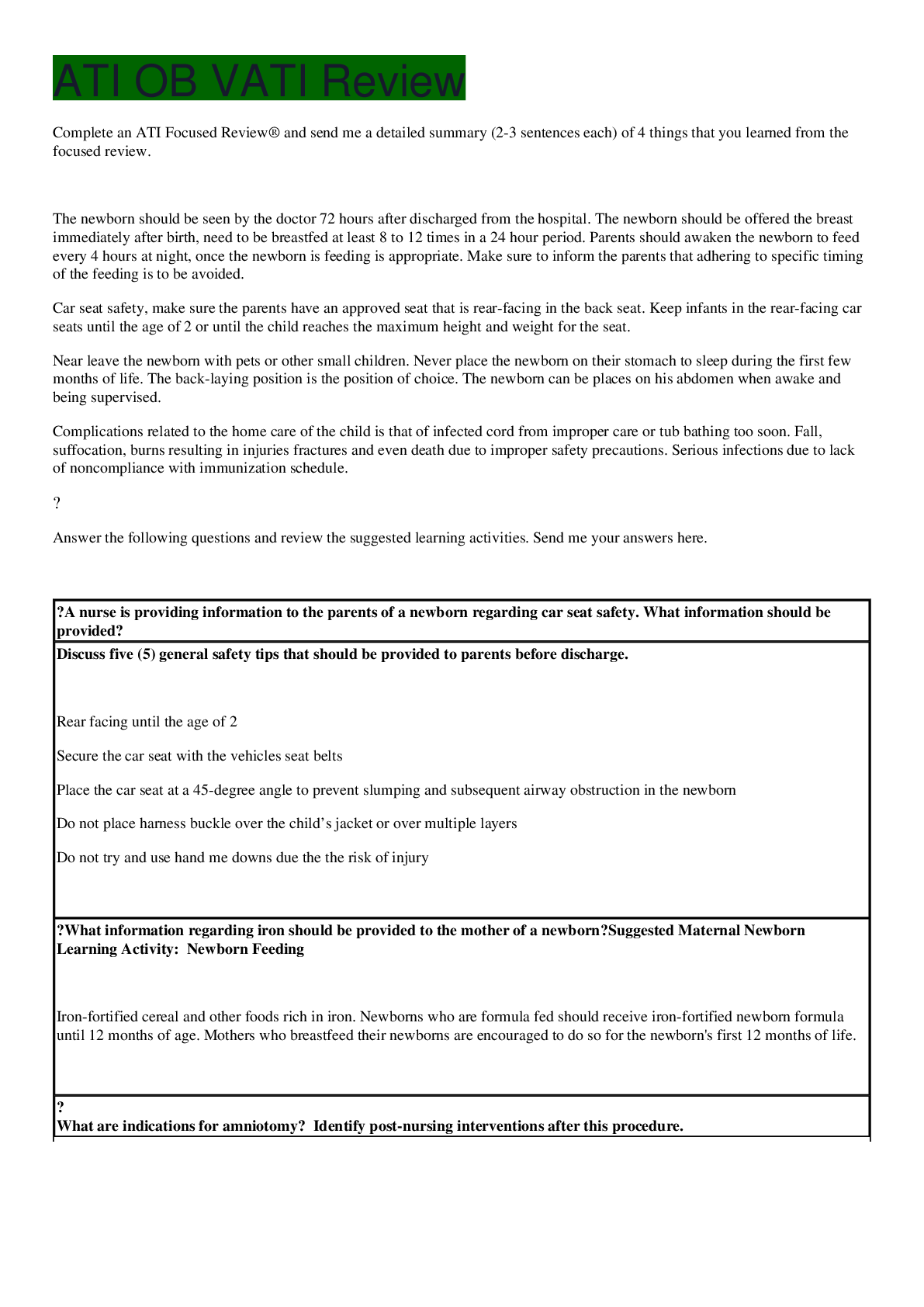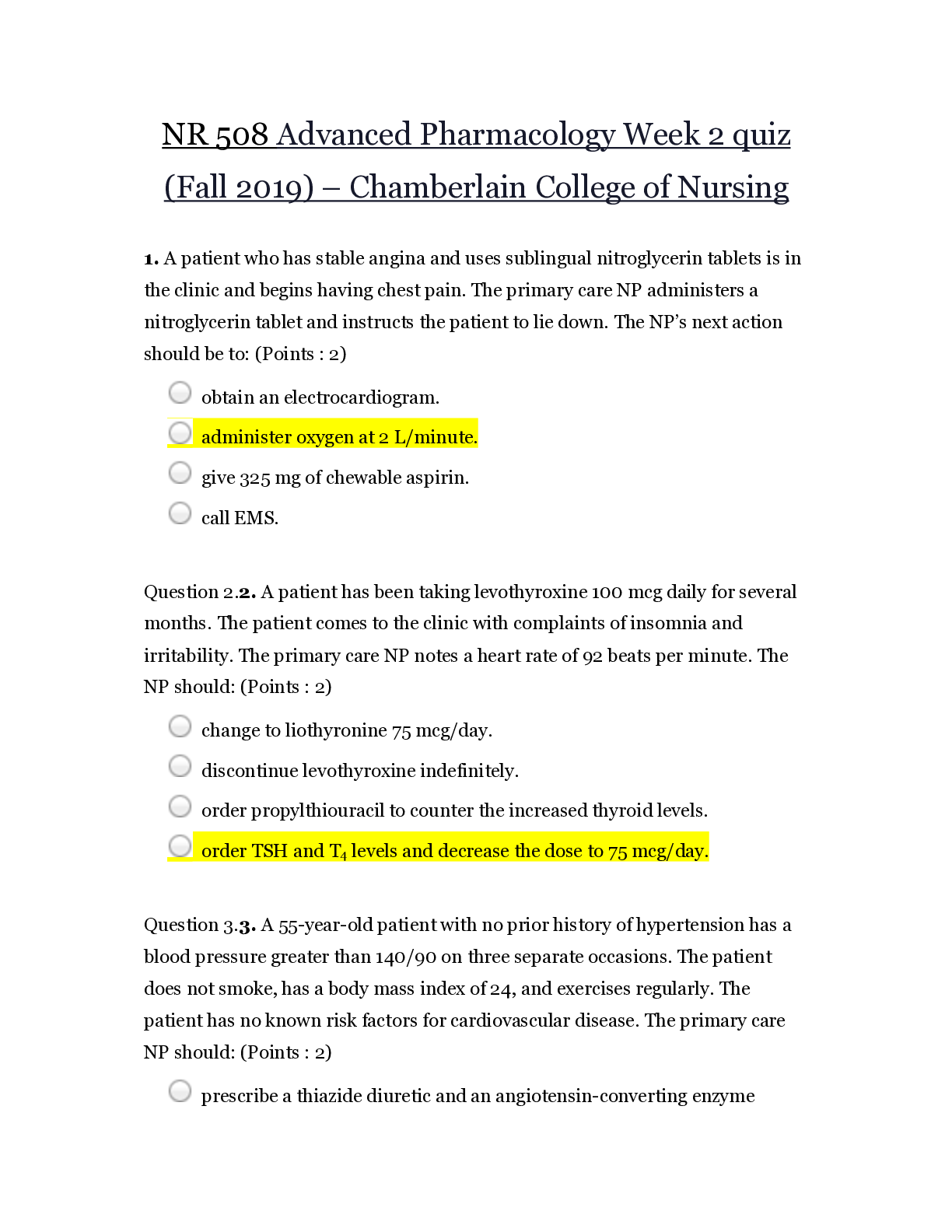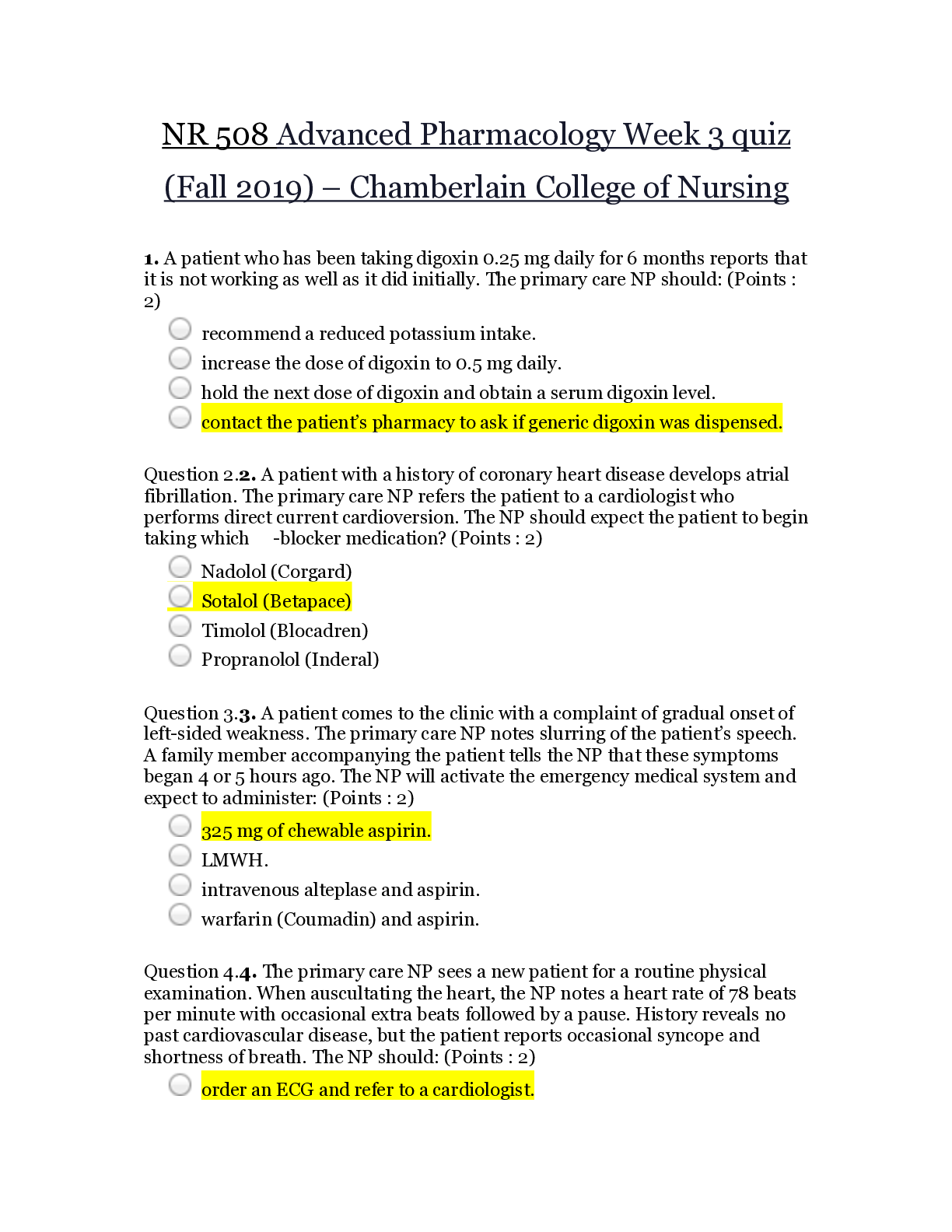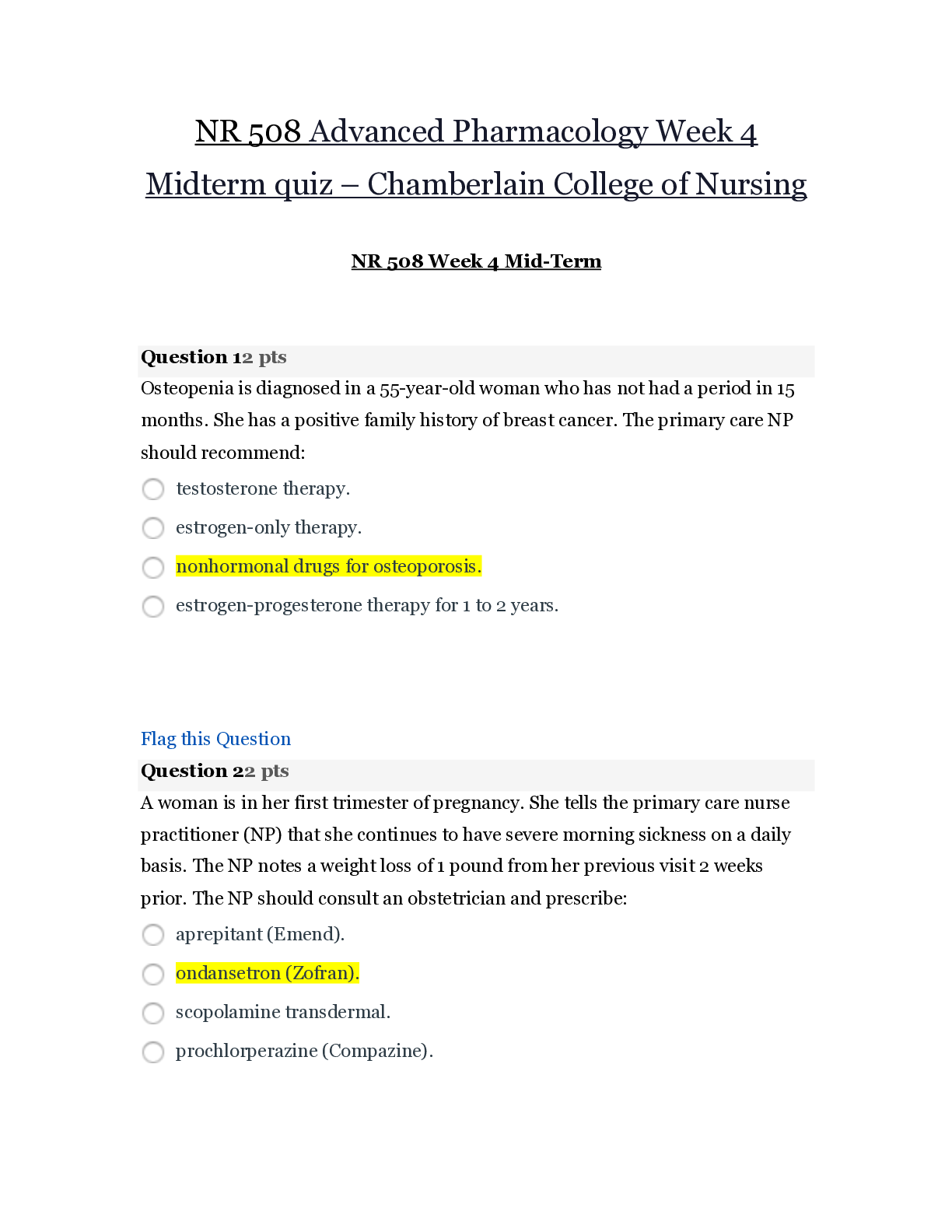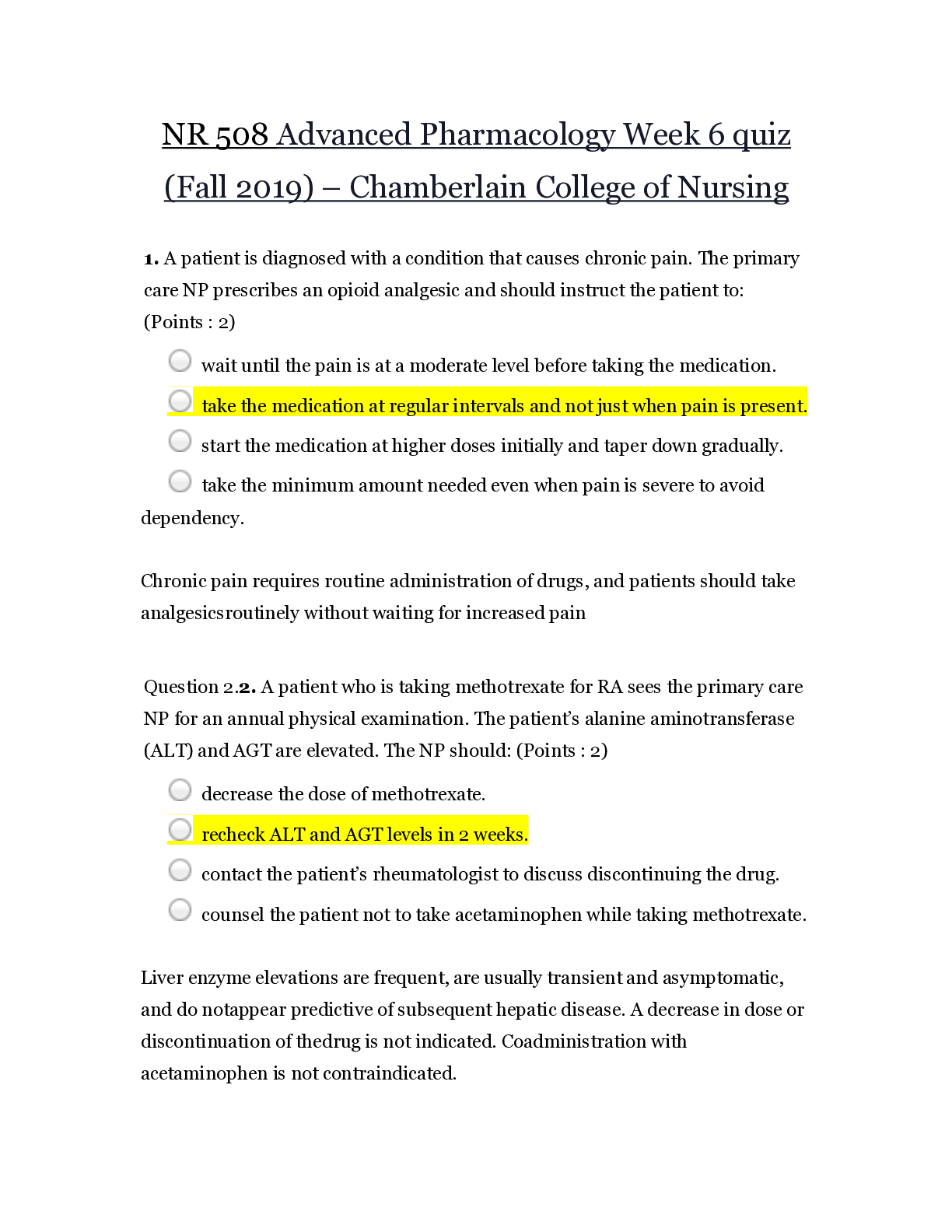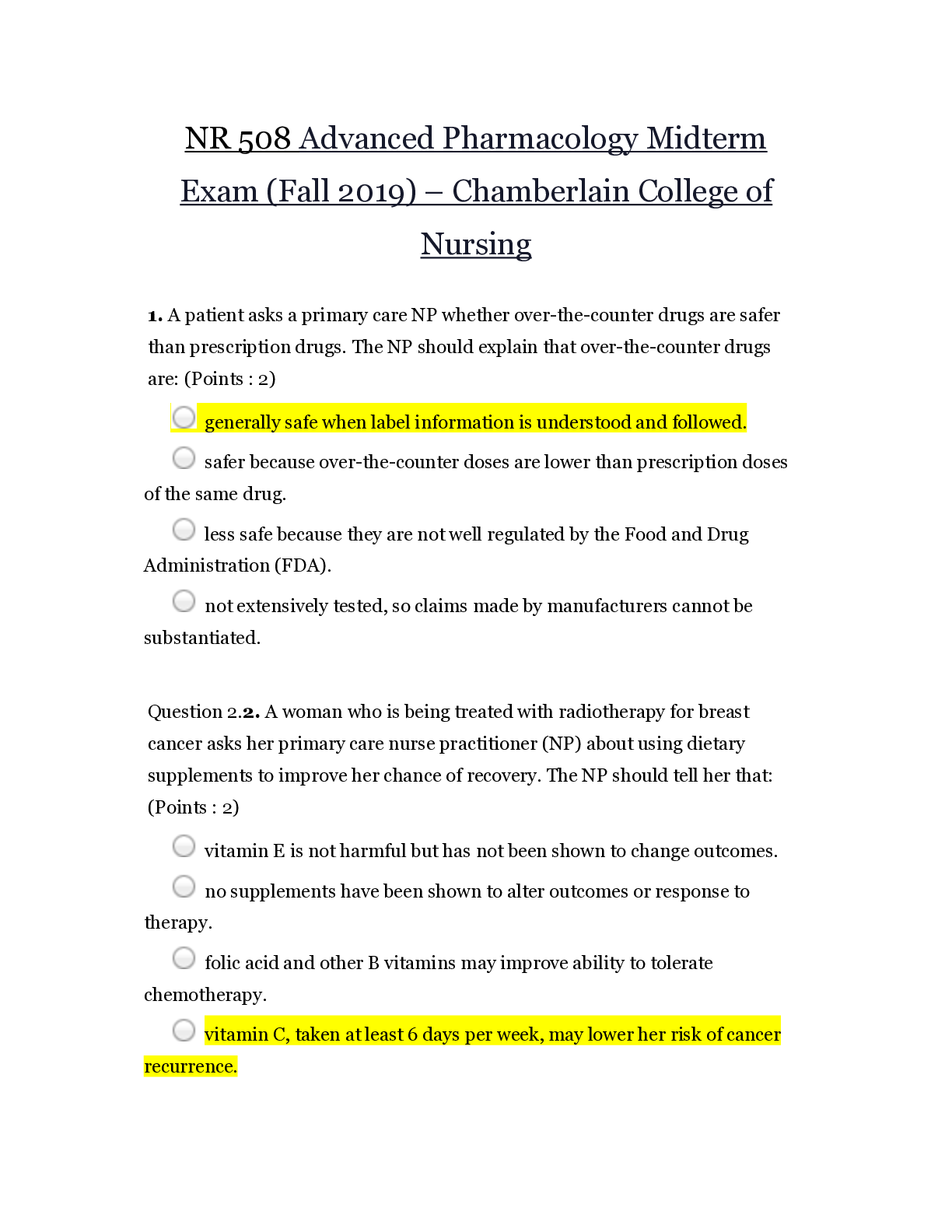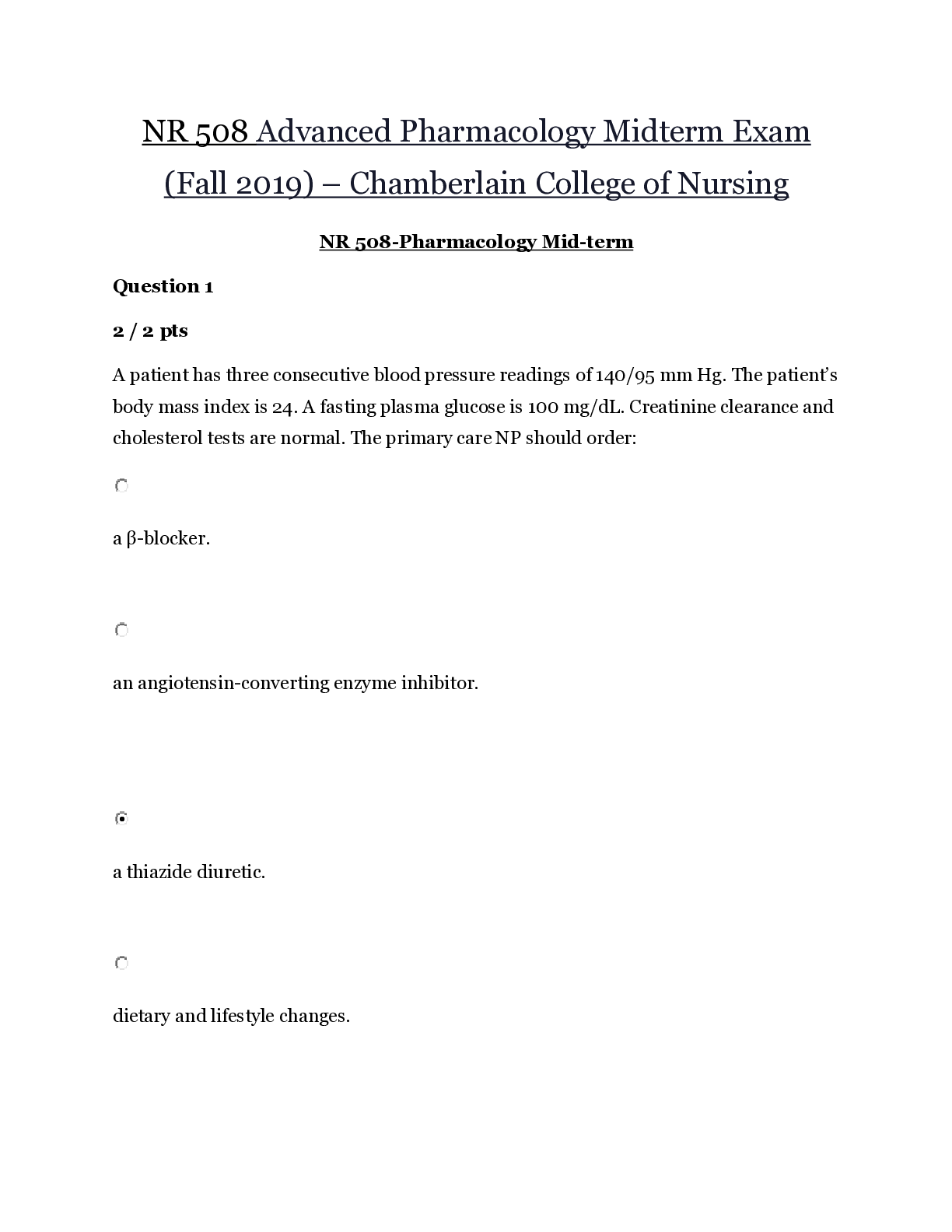*NURSING > EXAM > NR 224 FUNDIES I FINAL EXAM REV1 (updated) – Chamberlain College of Nursing | NR224 FUNDIES I FINA (All)
NR 224 FUNDIES I FINAL EXAM REV1 (updated) – Chamberlain College of Nursing | NR224 FUNDIES I FINAL EXAM REV1 (updated)
Document Content and Description Below
NR 224 FUNDIES I FINAL EXAM REV1 (updated) – Chamberlain College of Nursing • Bulimia Nervosa • Recurrent episodes of binge eating (rapid consumption of a large amount of food in a discre... te period of time) • A feeling of lack of control over eating behavior during eating binges • Recurrent inappropriate compensatory behaviors to prevent weight gain, such as self-induced vomiting, use of laxatives or diuretics, strict dieting or fasting, or vigorous exercise • Binge eating and inappropriate compensatory behaviors that both occur, on average, at least once a week for 3 months • Self-evaluation unduly influenced by body shape and weight • To prevent hypoglycemia, do not abruptly discontinue TPN but taper rate down to within 10% of infusion rate 1 to 2 hours before stopping. • Assess for signs of medical toxicity in older adult because: reduced glomerular filtration • Majority of absorption: small intestine • Indicate the use of z-track: last shot turned skin to colors • GI tract • mouth, esophagus, stomach, small intestine, large intestine, rectum, anus • small intestine: duodenum, jejunum, ileum • large intestine: cecum, ascending colon, transverse colon, descending colon, sigmoid colon, and rectum • Dose is incorrectly interpreted: NURSE is at fault • if pt. refuses medication: explain purpose/ educate why they are getting it/ ask why they don’t want to take it • excrete gaseous medication: cough and take deep breaths • expired medication: call physician • Nurse is going to administer pain medication for pt with peripheral IV. Notices red streak, warm and tender to touch = Phlebitis-iv site that is blown/bust, and the fluid just starts to puddle: DO NOT give pain medication. • Nurse is preparing medication to patients with same last name and did NOT check identification before administering medication: return to room to check and assess pt. • Pt did not take daily allergy medication in the morning bc felt too drowsy: change time to 9PM so drowsiness occurs when pt is sleeping • Successful goal of constipation: soft stool • Pt asks if she will be needing to have the bag (ostomy) on at all time: yes bc it by-passes the large intestine and constantly oozes liquid • Concerned if stoma is blue/purple/black • REE: consumed over 24 hour period for body to maintain all of its internal working • Pain meds. Cause constipation. 3 days without bowel movement=constipated • Major source of energy: carbohydrates • Black stool: iron ingestion-women take iron supps. A lot • Meet nutritional needs: do not gain or lose weight - nitrogen balance- negative is malnutrition, positive-healing • Breastfeeding is necessary for the first 4-6 months of life Cow’s milk can be drank after 1 year • Poor nutrition: short attention span; dry, brittle hair; dry, rough and pale skin • Colorectal cancer • African-americans are at highest risk • Risk factors: high animal fats and red meat; obesity, type 2 diabetes, smoking, and heavy alcohol • Causes of gyno----obesity, alcohol, liver cirrhosis • Warning signs: change in bowel habits; rectal bleeding; incomplete evacuation and unexplained abdominal or back pain • Colonoscopy: every 10 years after 50 years • Sigmoidoscopy: every 5 years after 50 • Pap smears: women get this test every year • C. diff: wash hands with soap and water • Infectious agent, reservoir, portal of exit, mode of transmission, portal of entry, susceptible host • Measure for NG tube: tip of nose, earlobe, xiphoid process • Administer eardrops • Children: pull auricle down and back • Adult: pull auricle upward and outward • Cotton • Apply gentle pressure to tragus of ear • Toxicity: kidney failure • BMI of 28: overweight • Opioids: constipation • Alcohol with opioids would make the effect work faster=synergistic affect • Deltoid needle: 22-25 and 1-1 and a half in • Valsalva maneuver: don’t have a aging adult do this because intracranial pressure • Inserting a suppository: Left-side with (right) knee bent • Feeding: • Too many medications, concerned with clogging: (what does nurse do?) • use liquid forms of medication, if possible • flush tube with 30 to 50 mL of water or normal saline before and after medication administration and before and after bolus feeding • flush with water every 4 hours for continuous feeding • answer: call the pharmacy and ask them to send you liquid form of medications • TPN total parenteral nutrition-through the central line • HTN medication and orange stool: question: what medications have you taken recently • Laxative: long-term can cause constipation • Older adult: calcium and vitamin D • Candidate for tube: throat cancer • nurse needs further teaching: (always prepare the regular insulin first) • Draw Regular insulin first, then the NPH in the syringe • NPH is intermediate • insulin garglane (Lantis) - always drawn in its own syringe (drawn alone) • Regular insulin is the ONLY insulin that’s given IV • IV is the fastest absorption • Topical is the slowest • Enteral feeding: cannot ingest food but can digest and absorb nutrients • Stop using ET when 75% of body needs are met, tapering method • Inserted right into the digestive tract like a J-tube, G-tube, NG tube • Candidates: functioning GI • Parenteral feeding: cannot digest, absorb -----problem with the GI so you have to get a central line close to the heart • Candidates: NON functioning GI • Side effect: unavoidable, predictable • Idiosyncratic effect: over/under-reaction or different reaction from normal, unpredictable ex: like if CNS stimulator and instead of becoming restless and have energy the patient falls asleep • At risk: motorcycle accident victim • Surgery: primary intention, clean incisions, approximated edges • Burn: secondary intention, burns, pressure ulcers, SCARRING • Tertiary intention: left open for 7 days until necrotic stuff is gone, and then it closes- because you don’t want to trap bacteria in the wound - - - - - - - - - - - - - - - - - - - - - - - - - - - - - - - - - ♣ antibiotics • Infection Prevention and Control to Reduce Reservoirs of Infection (box 29-10) o Bathing ♣ Use soap and water to remove drainage, dried secretions, or excess perspiration. o Dressing Changes ♣ Change dressings that become wet and/or soiled o Contaminated Articles ♣ Place tissues, soiled dressings, or soiled linen in fluid-resistant bags for proper disposal. o Contaminated Sharps ♣ Place all needles, safety needles, and needleless systems into puncture-proof containers, which should be located at the site of use. Federal law requires the use of needle-safe technology. Blood tube holders are single use only (OSHA, 2012) o Bedside Unit ♣ Keep table surfaces clean and dry. o Bottled Solutions ♣ Do not leave bottled solutions open. ♣ Keep solutions tightly capped. ♣ Date bottles when opened and discard in 24 hours. o Surgical Wounds ♣ Keep drainage tubes and collection bags patent to prevent accumulation of serous fluid under the skin surface. o Drainage Bottles and Bags ♣ Wear gloves and protective eyewear if splashing or spraying with contaminated blood or body fluids is anticipated. ♣ Empty and dispose of drainage suction bottles according to agency policy. ♣ Empty all drainage systems on each shift unless otherwise ordered by a health care provider. ♣ Never raise a drainage system (e.g., urinary drainage bag) above the level of the site being drained unless it is clamped off. • prevent infection control: o hand hygiene o change dressing and keep dry o adequate nutrition o shower, (NO BATHS, NO SOAKING) o gauze: pat dry o pain meds before dressing change • pneumonia (pg 423) o immobility (at risk), respiratory problems, elderly (age is a factor), heart failure, smokers, COPD, immunocompromised (HIV,AIDS), productive cough, green sputum, pain, wheezing o Deep-breathing exercises (1 to 2 hours), incentive spirometry, controlled coughing, and chest physiotherapy are among the nursing interventions available to expand the lungs, dislodge and mobilize stagnant secretions, and clear the lungs o fluid intake 1100-1400 mL (non-caffeinated) • assessing pulse: (palpate) o rate, rhythm, pulse strength, equality o apical: rate and rhythm only • infection: WBC (5000 - 10,000) and albumin (3.4 - 5.4 g/ dL) • protective isolation: protecting pt from us (bone marrow, HIV) • PCA o can: vitals, cleaning, HH, positioning, feeding, reporting o cannot: assessment, evaluate, meds • vitals: pain, grimacing, guarded, increased HR, increased BP, seating, agitated, restless • primary intention: surgical incision, minimal scarring o red: healing o yellow: slough o black/brown: eschar • secondary: trauma, burns • hand hygiene 1. wet hands 2. soap 3. 15 seconds 4. paper towels 5. close faucet • wet hands can bring on bacteria • do NOT use lotion • stroke pt o impaired swallowing (DYSPHAGIA); coughing when swallowing o follow up: thicken liquids = consult with speech therapist o suspect aspirating: possibly has pneumonia assess lung sounds (should hear crackles) o vital signs: decreased O2 sat, temp, give oxygen (do not need order) of 2L • check pulse Ox before NG Tube if continuous choking (short time) • walking with crutches: • For NG tube - make sure patient is in high fowler's if they can tolerate but NO LESS than 30 degrees for sure • semi fowler is: 30-45 degrees • fowlers 45-60 • high fowlers 90 degrees • aspirate 5-10 mL to test the PH and test PH before every feeding (4-6 hours) • residual volume: so if you see 250 on first time its okay, second time more than 250 STOP FEEDING - but if you see more than 250/500 STOP FEEDING and notify the doctor • make sure you put the aspirate back into the stomach because they can have an electrolyte imbalance if not • if the tube is in and patient is vomiting make them SIT UP b/c risk of aspiration - then check VITALS and call DR • continuous feeding 24 hours then throw OUT • to check residual pull back 30 mL • TO PUT MEDS IN TUBE: one at a time, flush w/ 10mL, crush, flush, crush (document ALL flushing) • if no residual - they are digesting and they should have a bowel movement • auscultate for lung/bowel sounds (before putting in tube) Diabetics • low carbs, monitor fruits because it is carbs=sugars Hypertension • lower sodium Diarrhea • avoid dehydration so make sure they are having a lot of fluids and monitor electrolytes because when you have diarrhea you lose electrolytes • after surgery: liquids, soft foods, and regular diet • BRAT: bananas, rice, applesauce, toast • fiber: barley, grains, oatmeal (increase these foods) • calcium: supplement vit D, dairy, green leafy veggies ANGLES of injections: • PPD (tuberculosis) - CAUSES A WHEAL (bleb) 5-15 • subcutaneous (insulin) - 45 degrees but if patient is obese then 90 degrees - PINCH SKIN • IM - 90 degrees and use 25 mL syringe 1 inch - VENTROGLUTEAL is best site if it's over 2mL but if it’s less than-use deltoid • intradermal: 5-15 degrees---TB test • Med-Cal o 1000 mL = 1L ♣ infuse at 200 mL/ hour in 18 hrs. how many mL • 3600 mL o 800 mL/ 5 hr ♣ 160 mL/ 1 hr o 750 mg: If you have 250 mg tablets. How many tablets would you give ♣ 3 o 1 cup = 240 mL o 1 tbs = 15 mL o 1 tsp = 5 mL o Tylenol (brand) ♣ acetaminophen (generic) ♣ 325 mg (dose) ♣ 325 mg / 100 mL ♣ 200 mL = 650 mg QUIZLET: https://quizlet.com/145786911/fundamentals-final-exam-practice-review-flash-cards/ some more information that I think will be helpful: WHAT CAN NAP DO? • position and move patients • apply elastic stockings • help patients use the incentive spirometer • apply nasal cannula • Assess skin every hour in immobilized patients • Convection: transfer of heat away from body by air ex: fan • conduction: transfer of heat from one part of the body to another with direct contact ex: sponge bath and cool compress • Radiation: transfer of air without direction contact • evaporation: liquid to gas • hypoxia: tissues • hypoxemia: low level of oxygen to the blood • inspiration: stimulated by chemical receptors in the aorta (ACTIVE PROCESS) • expiration: deals with the elastic recoil of the lungs (PASSIVE PROCESS) • left sided heart failure: pulmonary congestion like crackles, and paroxysmal nocturnal dyspnea • right sided heart failure is SYSTEMIC: edema, weight gain and distended neck veins • MI happens because there is a lack of blood flow due to an obstruction of the coronary artery and that is what supplies the heart with blood • Afterload: resistance to left ventricular ejection • Preload: amount of blood in the left ventricle at the end of diastole (end diastolic volume) • remember closed suctioning with mechanical ventilation ** Somewhere on the review I can’t remember where it says when you are inspecting the skin of a darkly pigmented patient use a HALOGEN light NOT fluorescent light (fluorescent is a mistake!) [Show More]
Last updated: 1 year ago
Preview 1 out of 30 pages
Instant download
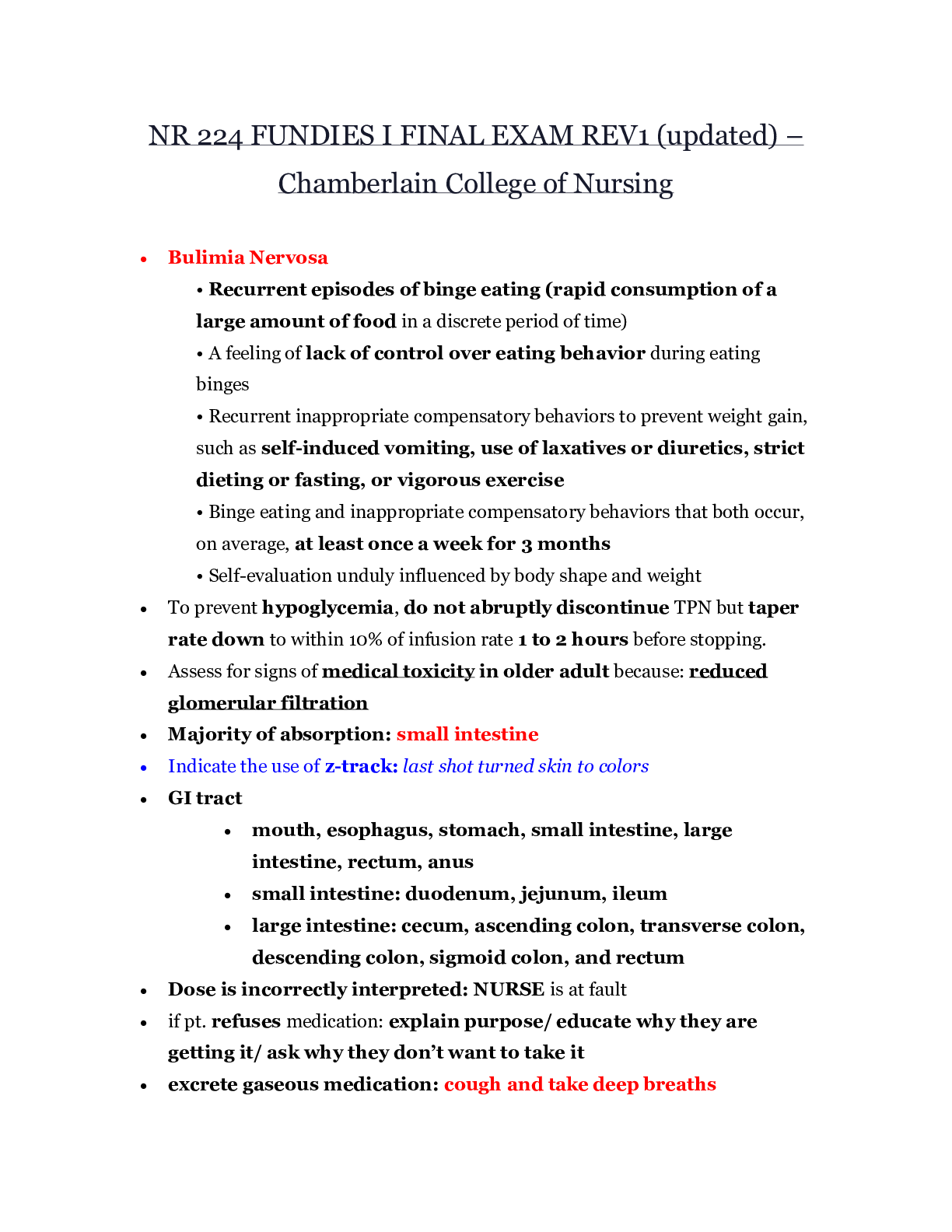
Buy this document to get the full access instantly
Instant Download Access after purchase
Add to cartInstant download
Reviews( 0 )
Document information
Connected school, study & course
About the document
Uploaded On
Jul 30, 2020
Number of pages
30
Written in
Additional information
This document has been written for:
Uploaded
Jul 30, 2020
Downloads
0
Views
38













